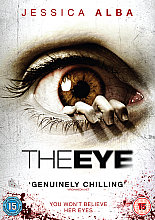Free Membership
Welcome to DVD-Movie-Sale.co.uk!
DVD Movie Sale is a comprehensive DVD site where you can search for any movie by genre, film title, actors name or director. Complete with full film information & synopsis as well as being able to compare prices for your favourite DVD from leading retail stores. You even have the opportunity to include your personal film reviews or give your personal ratings with numerous chances to win dvd related prizes.
Browse DVDs
Eye, The
Eye, The
 Stars: Parker Posey, Jessica Alba, Alessandro Nivola
Stars: Parker Posey, Jessica Alba, Alessandro NivolaDirector: David Moreau
Summary: Concert violinist Sydney Wells has been blind since she was five, when an accident involving firecrackers damaged her corneas. Now in her mid-20s, she has just undergone a transplant, a risky procedure that is not always successful. When the bandages come off, her sight slowly returns, and everything she sees is a new experience. A happy occasion becomes terrifying, though, when she begins to see horrifying visions of the dead.
THE EYE adapts the influential 2002 Hong Kong ghost tale by the Pang brothers into a star vehicle for Jessica Alba. While it remains faithful to the original story, this version ups the number of jolts for thrill-seeking Western audiences. Writing/directing team David Moreau and Xavier Palud, creators of the popular 2006 French thriller THEM, make their U.S. debut with a screenplay by Sebastian Gutierrez (SNAKES ON A PLANE), putting a few new twists on a cult favourite.
Concert violinist Sydney Wells (Alba) has been blind since she was five, when an accident involving firecrackers damaged her corneas. Now in her mid-20s, she has just undergone a transplant, a risky procedure that is not always successful. When the bandages come off, her sight slowly returns, and everything she sees is a new experience. A happy occasion becomes terrifying, though, when she begins to see horrifying visions of the dead. Fearing that she’s losing her sanity, she enlists the help of Dr. Paul Faulkner (Alessandro Nivola), who uncovers the identity of the donor of her new corneas and travels with her to Mexico to unravel the mystery of her horrific visions. Spare and effective, THE EYE retains the two most startling sequences from the original film--a truly chilling floating dead man in an elevator and an elaborate, explosive set piece at the conclusion. Moreau, Palud, and Gutierrez jazz the story up in other spots, with quick scares, sharp music cues, and twitchy apparitions reminiscent of those in JACOB'S LADDER, but the essence remains the same. Alba is fine as damsel in distress Sydney, and the always-enjoyable Parker Posey is uncharacteristically low-key as her airline hostess sister. With no gore or anything else objectionable, the film may also be good choice for younger viewers who enjoy a good scare.

WIN DVDS by being amongst the first to review this DVD. Reviewing DVDs earns you bonus entries and lets you WIN DVDs!Please login before reviewing this DVD. If you're a new user, register for free and enter to WIN FREE DVDs!

 Even though one can view each segment of Krzysztof Kieslowski's Three Colourstrilogy on its own, it seems absurd to do so; why buy the trousers instead of the entire suit? Created by Kieslowski and his writing partner Krzysztof Piesiewicz for France's bicentennial, the titles--and the themes of the films--come from the three colours of the French flag representing liberty, equality and fraternity. Blueexamines liberation through the eyes of a woman (Juliette Binoche) who loses her husband and son in an auto accident, and solemnly starts anew. Whiteis an ironic comedy about a befuddled Polish husband (Zbigniew Zamachowski) who takes an odd path of revenge against his ex-wife (Julie Delpy). A Swiss model (Irène Jacob) strikes up a friendship with a retired judge (Jean-Louis Trintignant) who eavesdrops on his neighbours in Red. The trilogy is a snapshot of European life at a time of reconstruction after the Cold War, reflected through Kieslowski's moralist view of human nature and illumined by each title's palate colour.
Even though one can view each segment of Krzysztof Kieslowski's Three Colourstrilogy on its own, it seems absurd to do so; why buy the trousers instead of the entire suit? Created by Kieslowski and his writing partner Krzysztof Piesiewicz for France's bicentennial, the titles--and the themes of the films--come from the three colours of the French flag representing liberty, equality and fraternity. Blueexamines liberation through the eyes of a woman (Juliette Binoche) who loses her husband and son in an auto accident, and solemnly starts anew. Whiteis an ironic comedy about a befuddled Polish husband (Zbigniew Zamachowski) who takes an odd path of revenge against his ex-wife (Julie Delpy). A Swiss model (Irène Jacob) strikes up a friendship with a retired judge (Jean-Louis Trintignant) who eavesdrops on his neighbours in Red. The trilogy is a snapshot of European life at a time of reconstruction after the Cold War, reflected through Kieslowski's moralist view of human nature and illumined by each title's palate colour.
On the DVD:The DVD set has numerous extras spread throughout the three discs; the end result is a superior collection. Each disc has a short retrospective, culled together from new interviews with Kieslowski's crew, plus film critic Geoff Andrew, biographer Annette Insdorf (who also does the commentaries), and fellow Polish director Ageniska Holland. Producer Marin Karmitz also reminisces about the experience. There's an exceptional effort to show the magic of Kieslowski (who died two years after the trilogy) through a discussion of his various career phases, interviews with the three lead actresses, four student films, and archival materials including simple--and wonderful--glimpses of the director at work. Excellent insight is also provided by Dominique Rabourdin's filmed "cinema lessons" with Kieslowski. Without viewing any of his other films, this set illustrates the uniqueness of Kieslowski. --Doug Thomas























